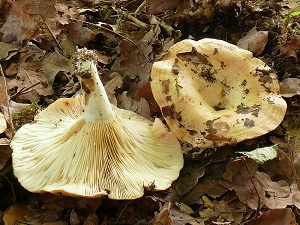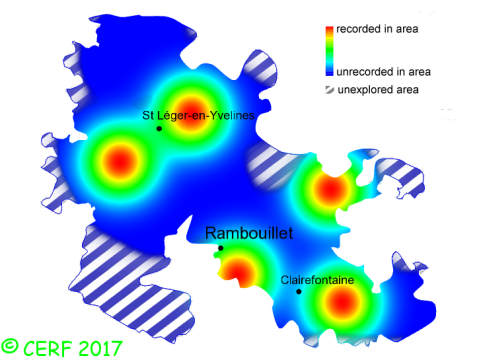| Lactarius zonarius (Bull.) Fr. |
|
|
|
|
|
|
The cap is pale buff to yellow, with ochre-pink to dull brown-orange concentric bands, convex to flattened, then depressed and eventually funnel-shaped; its margin is inrolled then wavy, slightly hairy in the youth. The cap surface is with thin russet concentric bands near the margin, smooth to silky, greasy rather than viscid in damp weather. The stem is cylindrical, whitish cream or concolorous to cap or even darker, sometimes covered with more or less numerous dots (variety), sometimes without (type), without ring. The flesh is creamy white, becoming pinkish in places in about a quarter of an hour when cut and exposed to air, then eventually pale grey; its taste is acrid and hot; the odour is fruity, aromatic, of grass or of resin; its texture is grainy (breaking like a chalk stick), exuding when cut a white milk, hot, abundant and unchanging. The gills are white to saffron, adnate to decurrent, close, narrow and easily breaking (nb of gills per 90° ~ 35 ). The spore print is cream to pale ochre (E-F). This species is mycorrhizal. It grows on the ground, in broad-leaved woods, on a rather calcareous soil, more often in low grounds, most of the time with oak, but also with chestnut, beech, birch, hornbeam. The fruiting period takes place from July to November.
Distinctive features : ochre-yellow cap, funnel-shaped, with thin orange concentric bands especially at the margin; whitish stem, often spotted with darker blotches; abundant, hot milk, white, unchanging; flesh turning slowly to pink when exposed to air; with broad-leaved trees (oaks), on calcareous soils Lactarius zonarius is quite rare and localised in the forest of Rambouillet, and is infrequent, more generally speaking . | ||
|
page updated on 14/01/18

